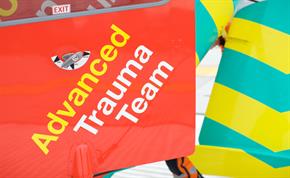For patients suffering a major trauma, time is of the essence but there is a fine balance to be found between staying on scene to optimise care and getting the patient to hospital as quickly as possible.
Interventions to stabilise the patient and optimise physiology will always need to be done prior to moving to hospital. In the event of an enhanced care team (ECT) being deployed to scene to assist with treatment, triage and transport, there are certain aspects of treatment that can and should be done to ensure minimal on scene time, especially if potentially being transported by helicopter.
The following optimisations can be done:
- Skin to scoop – with dignity in mind, ensure all unnecessary clothes are removed, cut off if needed, to expose the patient fully. This is to allow full body examination and access, especially if advanced procedures are needed to be done such as ultrasound, femoral lines, chest drains or thoracostomies; it speeds up transit time in hospital if needed to go direct to a CT scanner or theatres and it will allow you to identify injuries to the back and long bone. It will also save time for the ECT.
- With the above in mind, keep the patient warm and oxygenated. The lethal triad of trauma: hypothermia, acidosis and coagulopathy which all contribute to each other. Cold inhibits clotting cascade causing coagulopathy; vasoconstriction as a result of hypothermia and continued loss of blood will cause poor tissue perfusion and acidosis. The patient needs to be actively warmed with aggressive haemorrhage control to maintain a normothermia of 36-37ᵒC and avoid the lethal triad.
- Two large IV lines. The bigger the better, and as central as possible e.g. ACFs. Where multiple staff are on scene, the sooner these can be established the better bearing in mind it shouldn’t delay primary survey, moving or priority treatment of the patient but knowing that if they are bleeding, a vein that is available now, may not be in five minutes time once the patient is further compromised. Avoid giving fluids in the major trauma patient unless the patient appears shocked, has no radial pulses or has a marked reduction in conscious level and ETA to hospital is going to be greater than 30 minutes. Permissive hypotension to a SBP of 80mmHg with GCS 15 will ensure enough perfusion of the essential organs whilst not raising the BP that might break initial clot formation.
- Once the patient is packaged and secure on a scoop with head blocks and straps in place, lift the patient from the floor and on to a trolley ready for treatment and transport. If after arrival the medical team need to perform an RSI (emergency anaesthetic) this will always be done on a trolley, off the ground. Whether transporting by air or land ambulance, the trolley will be needed to get them there so it’s another step towards minimising scene time. It also simply allows for an easier assessment of the patient and the potential to move to an area for 360 degree access to the patient.
As with all cases of trauma or critical care, the critical care desk clinician can be called 24/7 on channel 202 to discuss the best options, treatment plans and resources available for the major trauma patient.
Published 30th May 2015
